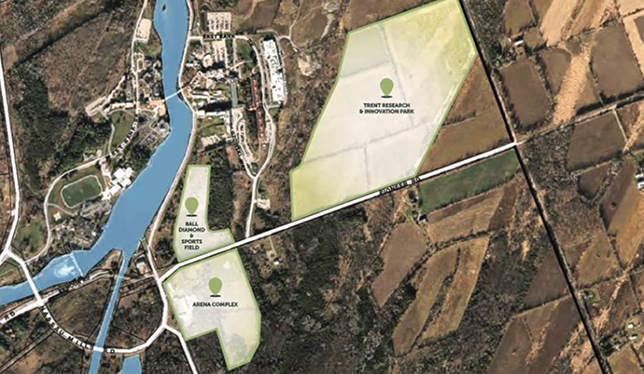In the spirit of Newton’s third law – for every action, there is a reaction – Trent University president Leo Groarke explained why his institution wanted and needs the new research park on its main campus in Peterborough, Ontario.
“It’s driven by challenged government support over the past two decades and in that context, it makes sense for universities to look at other revenue streams in order to continue their mission,” said Dr. Groarke. “Taking the development of our lands seriously is one way of doing that. Our park project is very ambitious for a small university like ours, but we welcome that and we’re very bullish about it.”
Approved by the university’s board of governors in June and by Peterborough City Council on July 31, the nascent Trent Research and Innovation Park becomes the 27th university research park in Canada and the first to focus exclusively on green technologies and renewable resources.
Backed by $2 million in investment from the university and $12 million in infrastructure spending by the city, the new park will be developed on an 86-acre site that is currently being used as farmland in north-end Peterborough. Though equivalent in size to 43 Canadian football fields, the site represents only a fraction of Trent’s sprawling 1,500-acre property, only 180 acres of which are used for the main campus and the school’s 8,500 students (plus another 1,000 students at Trent’s satellite campus in Oshawa, Ontario).
According to the project’s master plan, the park will be designed to attract both established and start-up businesses that provide or develop goods and services in everything from clean technology and environmental and advanced material sciences to biotechnology and agri-food. The site will also follow six design principles that include its integration with Trent’s main campus “physically, visually and socially,” and the maintenance and protection of natural features and existing topography such as the Otonabee River and marshlands that are home to many wildlife species, including 20 species at risk.

Before he joined Trent in 2014, Dr. Groarke spent 10 years spearheading the development of Wilfrid Laurier University’s new campus in the economically hard-hit downtown of Brantford, Ontario – an experience he credits with helping him learn how to work with a city government and making Trent’s decade-old dream a reality. “We’re still very early on and we need to first build basic roads and sewers,” said Dr. Groarke. “But this park has the potential to transform the community the same way the formation of Trent did 50 years ago.”
Andressa Lacerda agrees. As chief commercial officer and co-founder of Noblegen, an advanced biomaterials company and the Trent park’s first official tenant, she is excited by the prospects of bringing like-minded businesses, faculty and students together under one roof.
“I love teaching,” said Dr. Lacerda, a Brazilian-born, Trent-educated biologist who started Noblegen with Canadian scientific whiz kid Adam Noble in 2013. The company now has 40 employees working at on-campus labs and in production facilities in Peterborough’s south end. “I can see me giving lectures in our facility … to allow students to see firsthand what they could do with their training,” she said. “A lot of students who are finished or who are about to finish have no idea what to do or how to apply a science degree to business. This park will help do that by providing them with a window on the real world.”
The experiences of Canada’s other university research parks suggest that Trent’s bold bid to create a hub for start-ups focused on green technologies is no pipe dream. According to recent data from the Association of University Research Parks Canada, a non-profit group that advocates on behalf of its now 27 members, these parks contribute nearly $4.5 billion to Canada’s gross domestic product and employ more than 65,000 people, more than a third of whom have advanced degrees. Three-quarters of parks also house technology incubators and accelerators, and nearly half of the companies located in these research parks say they plan to expand.
“These parks are economic engines,” said Laura O’Blenis, co-founder and managing director of AURP Canada. Though no two parks are set up and run the same way, Ms. O’Blenis said the most successful share a common trait: “They are very focused. Having a very narrow and well-defined focus helps them to find and attract companies.”
A tight focus has certainly paid dividends for the University of Waterloo’s David Johnston Research + Technology Park. Inaugurated in 2006 on the school’s north campus, the 120-acre park has reached nearly 70 percent capacity with around 100 high-tech companies whose primary focus is the development or manufacture of Internet-connected devices, robotics, sensor technology and related hardware.
“The park is an extremely high-profile project,” said park manager Michael Pereira. In addition to attracting research companies that come to partner with faculty members and graduate students, and offer co-op opportunities to undergrads, Mr. Pereira said the park’s tenants pay rent and attract research money. “It generates substantial revenues that we can plow back into education and research,” he said. “It’s been a great bump for our bottom line.”